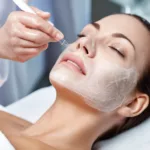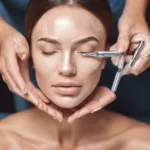26 November 2023
Discover the Benefits, Risks, and Procedure of Dermaplaning
In the pursuit of flawless skin, individuals are constantly seeking innovative skincare treatments. One such procedure gaining popularity is dermaplaning, a minimally invasive technique that involves shaving away the top layers of skin to reveal a brighter complexion underneath. With potential benefits ranging from reducing acne scars to exfoliating dull skin, dermaplaning has become a sought-after treatment. This article explores the intricacies of dermaplaning, including its benefits, risks, and the steps involved in the procedure.
Dermaplaning: A Deeper Look
Dermaplaning is a skin resurfacing treatment that utilizes a handheld surgical device called a dermatome. Resembling a scalpel, the dermatome gently shaves off thin layers of skin and hair, either on specific problem areas or the entire face. It can be performed as a standalone treatment or in conjunction with other skincare procedures. The primary objective of dermaplaning is to reduce the appearance of fine lines, wrinkles, and acne scars.
Differentiating Dermaplaning, Dermabrasion, and Microdermabrasion
While dermaplaning, dermabrasion, and microdermabrasion all involve removing the top layers of skin, they differ in terms of tools used and the extent of skin removal. Microdermabrasion employs microcrystals or a diamond-tipped device, followed by a vacuum-like suctioning process to eliminate dead skin cells. Dermabrasion, on the other hand, utilizes an electric rotating brush to remove uppermost layers of skin, resulting in more dramatic results. Dermaplaning, with its scalpel-like dermatome, allows for deeper exfoliation than microdermabrasion and can remove more layers of skin and hair.
The Benefits of Dermaplaning
Dermaplaning offers a range of potential benefits, including:
1. Reducing the appearance of fine lines and wrinkles.
2. Minimizing acne scars and pitted skin.
3. Brightening dull and dry skin.
4. Removing vellus hair, also known as “peach fuzz.”
5. Improving overall skin texture.
6. Treating sun-damaged skin.
7. Enhancing the absorption of skincare products.
8. Preparing the skin for other treatments or surgical procedures.
Who Can Benefit from Dermaplaning?
Dermaplaning is suitable for individuals looking to improve the texture and appearance of their skin. Those with sun-damaged skin, signs of aging, or specific skin conditions like rosacea may opt for dermaplaning to achieve smoother and brighter skin. However, individuals with active acne breakouts, cold sores, skin rashes, burns, moles, or skin tags should avoid dermaplaning.
Preparing for a Dermaplaning Session
Before undergoing dermaplaning, a consultation with a dermatologist or aesthetician is essential. This allows for a discussion of treatment goals and potential risks or side effects. Patients may be advised to cleanse their face, remove makeup and skincare products, and refrain from using certain medications, such as topical acne products, in the days leading up to the procedure.
The Dermaplaning Procedure
During a dermaplaning session, a numbing cream or anesthesia may be applied to minimize discomfort. The clinician will then use the dermatome at an angle to gently remove the top layers of skin. While the procedure is typically painless, patients may experience slight pressure from the instrument. The duration of a dermaplaning session can range from minutes to an hour.
Post-Treatment Care and Risks
Following dermaplaning, skincare products may be applied to facilitate deeper penetration. Visible results are often immediate, although some redness or sensitivity may persist for up to three months. While dermaplaning is generally safe, there are potential risks, including scarring, nicks and cuts, fever blisters, skin irritation, and thickened skin. However, these complications are rare.
The Need for Multiple Dermaplaning Procedures
Dermaplaning results are not permanent. Hair removal through dermaplaning may last several weeks before regrowth occurs. To maintain ongoing improvements in skin texture and appearance, many individuals opt for monthly dermaplaning sessions.
Conclusion:
Dermaplaning has emerged as a popular skincare treatment, offering a range of benefits from reducing acne scars to exfoliating dull skin. While risks exist, dermaplaning performed by trained professionals is considered safe and effective. To determine if dermaplaning is right for you, consult with a dermatologist and embark on a journey towards brighter, smoother skin.



